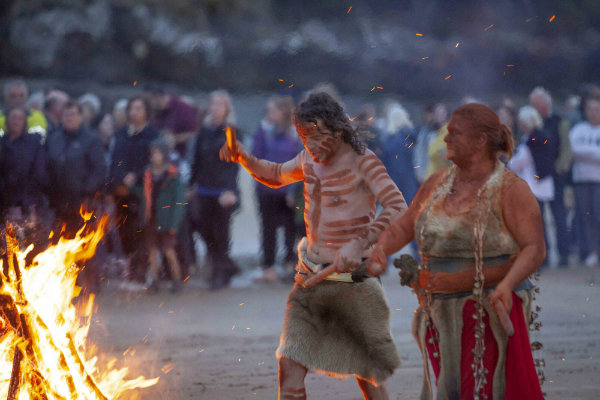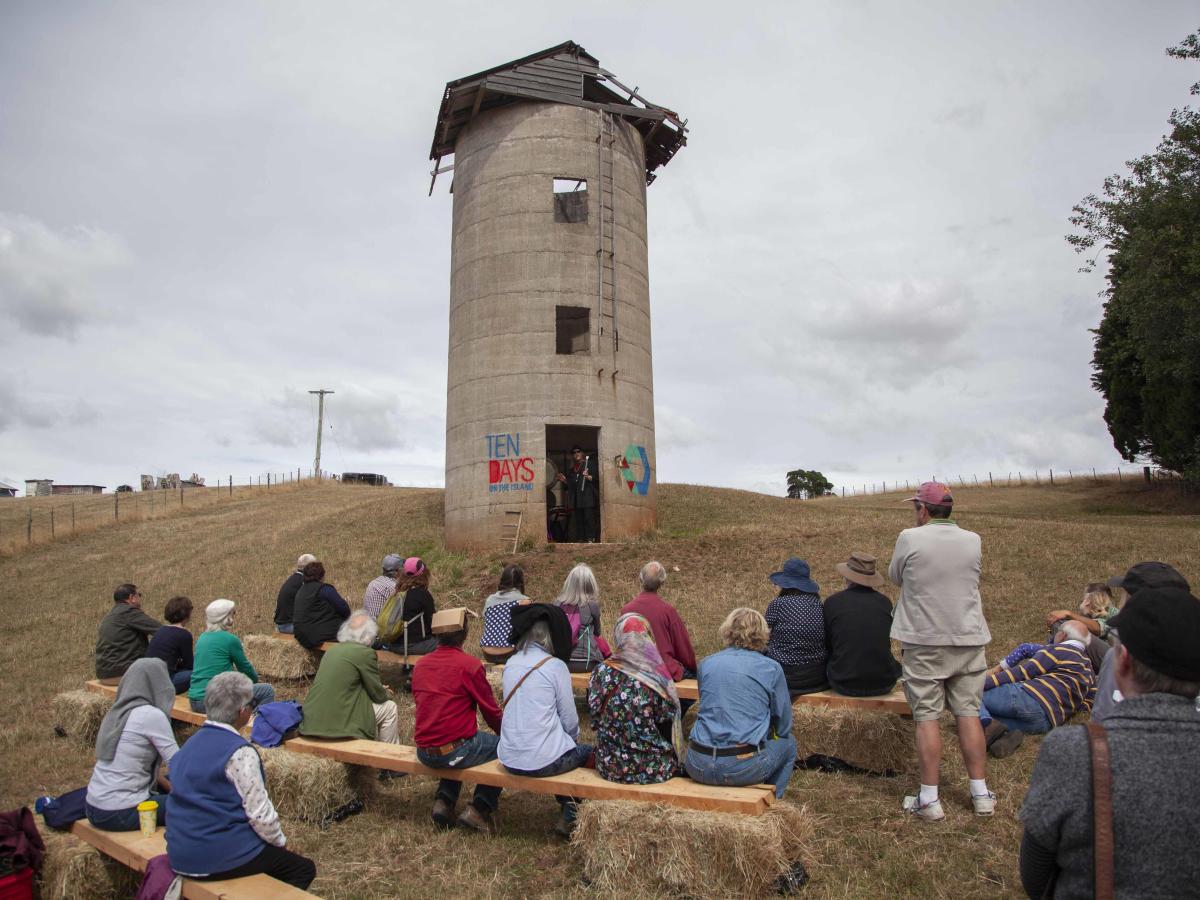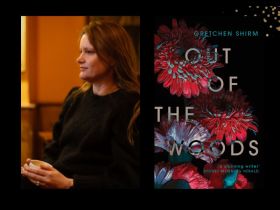Big hART’s Acoustic Life of Sheds at Ten Days on the Island. Photo credit: Sonja Ambrose.
I’m writing this from Table Cape, a spectacular stretch of volcanic rock facing the wide expanse of Bass Strait, about 25 minutes from Burnie in Tasmania. I’m watching an echidna amble its way up the grassy path to the rocks and reflecting upon the first of three weeks of immersion in the Ten Days on the Island Festival.
Billed as ‘an epic adventure over three weekends’, the festival is a tantalising mix of local, national and international work spread across the centres of Burnie, Launceston and Hobart and towns between them. The hope being, that not only will people get to see work for and from their communities, but that they will also be drawn to explore places and possibilities outside their geographical and cultural comfort zones. Tasmania’s biennial Ten Days on the Island is the only ‘whole of state’ arts and cultural festival in Australia and with it comes the opportunity to do things a bit differently.
There is a small revolution going on in North West Tasmania, one that nurtures and challenges in equal measure. What manifests from this approach is a festival that is grown from, rather than superimposed on its communities. Ten Days on the Island is a festival that both celebrates the very essence of Tasmania and inspires local artists to look outside of the insularity that emerges from island life.
You can’t be Tasmanian without embracing the landscape’s ruggedness and harsh climate, its ever-changing skies, its multitude of uncrowded beaches but perhaps most importantly, its loyal, close-knit sense of community.
What Artistic Director Lindy Hume and the team at Ten Days on the Island have done is to throw away the idea that virtuosity can’t sit alongside deep community engagement and outcomes. They’ve found a way, in the North West to succeed in doing both.
A fantastic example of this is Here She Is in Devonport’s Stewart Street Gallery. Local artists Jessie Pangas and Anne Morrison have developed an exhibition created by and about multiple generations of North West women. At the opening, on International Women’s Day, the room is filled with excited ladies and grandchildren running up to pictures proudly stating ‘This is my Nan’. There’s a lovely, supportive sense of curiosity and pride as the crowd weaves its way through the stories, connected through threads on the wall via geography, family and country.
The exhibition profile of Dr Emma Lee, a Trawlwulwuy woman now living on the northern coast of Tasmania, is striking – she’s got the kind of piercing eyes that seem to follow you around the room. In her interview, displayed sonically as part of the exhibition, she says ‘I am nothing without these things of country’. She goes on to explain that as North West Tasmanians, there is a particular moral pathway, a set of values that are built on the basis of country and a sense of belonging that connects.

Mapali at Ten Days on the Island. Photo credit: Sonja Ambrose
A festival that mirrors its Confederation of Australian International Arts Festivals contemporaries on mainland Australia just wouldn’t cut it here. To capture, engage, and embrace this community, Tasmanians need a state festival that is simultaneously authentically engaged with community and world class in quality.
Ten Days on the Island is listening to communities and artists; they are doing it publically as an integral part of the festival’s program – in talks, conversations and small open sessions. Festival staff are exchanging ideas, hearing concerns and being accountable in a way that is refreshingly transparent.
The festival team, a small and committed core group of ten, describe the festival as an instigator, developer and researcher. They see and hear the needs of the arts community and they are responding. These values are clearly evident in the first weekend of the festival and in their approach to programming.
Venus Infected by leading Māori artist Lisa Reihana can be viewed in a found space in Burnie. It is mesmerising, layered and affecting. At the other end of Burnie you can visit Tasmanian Aboriginal artist Lola Greeno’s exhibition milaythina-nika waranta; waranta milaythina-nika. katina-mana mara at The Makers Workshop. These two female artists are skillfully exploring their Indiginaity in very different ways. If the Festival’s goal is to bring extraordinary international art here and give extraordinary Tasmanian artists a chance to develop work, Artistic Director Lindy Hume and Creative Producer Vernon Guest have succeeded in the first weekend simply within the two extremities of the main strip of Burnie.
Jane Haley, the Festivals’ CEO, is as committed to building pathways and creating skills development opportunities for Tasmanian artists and arts workers as she is to thrilling festival audiences.
A good example of this is the festival’s co-commissioning of Gravity and other Myths’ Out Of Chaos, the company’s first performance in Tasmania. As part of the commission Gravity and Other Myths worked with local group Slipstream Circus to develop new skills. The show is clearly an audience favourite in Burnie, evident by the large and diverse crowd. The performance has captured the imagination of the broad shouldered young local circus performers, the arts crowd from Hobart, venue subscribers and families coming for the first time. This is not your traditional circus work though, and it doesn’t shy from challenging the audience through the eclectic range of physicalities chosen to express an abstract and sometimes dark physical and acoustic language.
The day after the performance, a local Drama and English teacher at a festival talks session spoke about being inspired to push the boundaries of youth performance as a result of seeing the show. To truly push and shift perceptions of contemporary performance you need to bring the audience with you, and the Festival’s programing choices clearly reflect a desire to do so.
A festival that mirrors its Confederation of Australian International Arts Festivals contemporaries on mainland Australia just wouldn’t cut it here.
Ten Days on the Island is committed to long-term partnerships, the antithesis to the ‘churn and burn’ mentality often synonymous with the festival landscape. An example being their partnership with Urban Theatre Projects, who are working on a significant project with the Shorewell Community over four years.
Tasmania has a number of ‘hard infrastructure’ challenges. Flexible, well-equipped performance venues without the restraints of proscenium arch, large stages big enough for epic large scale work, and fixed rigging capable of doing complex aerial work are all hard to come by. Instead of butting heads over these challenges the Festival looks for opportunities elsewhere. While a lot of work can be found in dedicated permanent arts spaces, the festival also lands you smack bang in the pastoral and native landscapes that make Tasmania so different from the mainland, again resulting in a very different festival experience when compared to the likes of Adelaide or Melbourne Festivals.
Over the last three days I’ve ventured down laneways swarming with butterflies to see work in sheds and clambered bleary-eyed onto a beach at dawn in Devonport for a spectacular and deeply significant Palawa welcome. There are opportunities in the program also, to immerse oneself in Cradle Mountain or Cataract Gorge and venture into the wetlands to see work. Visitors and Tasmanians alike don’t need to choose between experiencing the arts or the natural experiences of Tasmania – the festival itself provides a brilliant road map for the kind of adventure that celebrates both, and provides a welcome open door to first time arts audiences.
On the end of the first weekend of the festival I found myself at Acoustic Life of Sheds – a tour of the small communities of the North West coast presented in partnership with Big hART. The project is a series of rolling, purpose-made music performances spanning 60 kilometres over four and a half hours in little pockets of the West Coast and we end the weekend singing along with a crowd of strangers and raising our glasses of North West Tassie cider in appreciation.
I’m looking forward to the next two weeks, and sharing the adventurous journey of this unique festival with you. Next up: Launceston and the North East of Tasmania.
tendays.org.au
www.kathmelbourne.com.au





